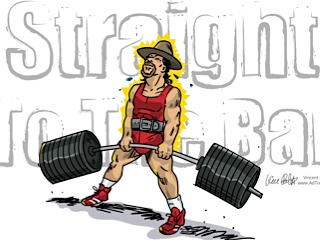
The Wrist-Roller is a classic piece of gym equipment, and rightfully so – it’s a great way to strengthen and develop the muscles of the hand, wrist and forearm. The standard model of Wrist-roller involves a short bar connected to a rope or cord, which attaches to the weight. The bar is held either in front of the user – which usually results in the shoulders tiring long before the forearms and wrist – or with arms straight down whilst standing on benches or boxes to allow the rope to hang down. The problem with the ‘free-standing‘ design is that you have to support the bar throughout the set, severely limiting the weight that can be used, as well as leaving the forearms under worked.
In the last few years the ‘mounted‘ wrist-roller has appeared and offers a solution. Usually consisting of a bar which can slide over a barbell or a pin in a power-rack, it takes out the supporting element of wrist-rolling and lets you really hammer your lower arms.
The downside? Cost.
This doesn’t have to be a problem though – here’s a guide to making your very own power-rack mounted wrist-roller:
What you’ll need :

- PVC pipe (any diameter)
- Hose clamp (to fit PVC pipe)
- Rope/Cord (4 – 5 feet)
- Carabiner or Quick-Link Connector
- Hack Saw to cut PVC pipe
- Loading Pin (optional)
- The first thing you’ll need to do is measure the space in which the roller will be used. The PVC pipe should be cut slightly shorter than the space so it fits without getting stuck – a one or two inch gap each side will be plenty.
- Next you will slide the hose clamp into the middle of the pipe and thread about 6″ of your rope or cord between the hose clamp and the PVC. Tighten up the hose clamp then tie a couple of knots in the cord for a bit of extra security.
- The rope should be cut to about 4 or 5 feet and the end will be knotted securely around the carabiner or quick-link connector (pictured).
- Hold the pipe between the uprights in the power-rack and slide the pin through. You can vary the height you use to hit the lower arms differently – somewhere around chest height is probably the strongest position.
- Attach weight by running the carabiner through the hole of a weight plate or the handle of a kettlebell and snapping it over the other side of the rope. You could also attach the connector to a loading pin for even quicker weight change.
- Now you can roll away until your forearms are on fire – and when you’re done just detach the weight, slide out the pin and throw the roller in your gym bag!
Step-by Step :
In Action :
One of the many advantages of the mounted wrist-roller over a free standing model is that it allows you to perform wrist-curls and extensions. I’ve found this particularly useful for wrist extensions as it takes away the pressure from your thumb, allowing you to focus the work on the oft-neglected extensors.
Notes :
Scratching the handle or wrapping it with athletic tape will afford you a better grip on the PVC and is a good idea to help prevent your hands slipping. Having said that, a smooth surface will force you to grip harder to maintain a good hold, which some of you may enjoy.
Consider making a couple of wrist-rollers with different diameter pipe – PVC is pretty cheap and comes in a wide variety of sizes – go narrow to focus on the wrists and thicker for some killer grip work.
Rollin’ :
There ya go – a quick, easy and convenient wrist-roller that will let you take your lower arm development to the next level. Enjoy the pain!











0 Comments